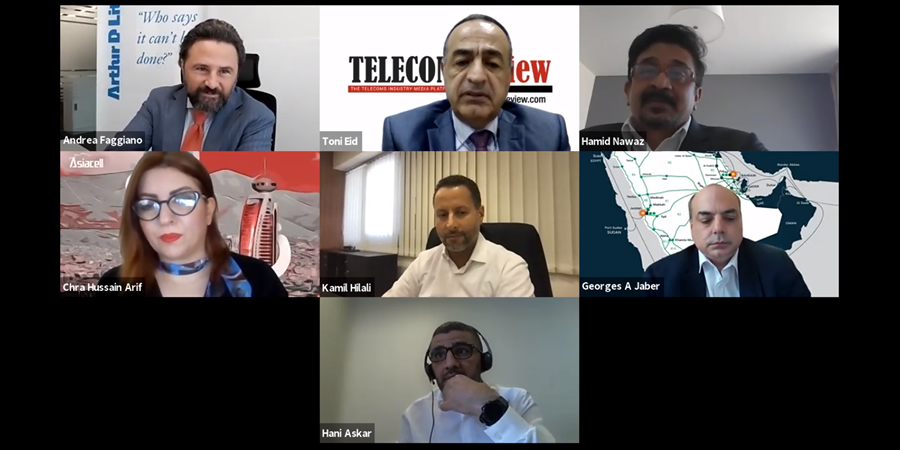Telecom Review, the Middle East’s leading ICT media platform, held a webinar titled ’Revolutionizing Connectivity Through Innovation’ on September 13, powered by SES, the world’s leading connectivity provider.
The moderator of the virtual event was Andrea Faggiano, Partner, Telecom, Information, Media & Electronics Practice Lead, Arthur D. Little Middle East. Accordingly, C-level speakers within the panel’s sponsor company and leading telecom operators in the Middle East were featured as panelists.
These are namely Hamid Nawaz, general manager, Middle East & Central Asia, SES; Chra Hussain Arif, chief commercial officer, Asiacell Iraq; Kamil Hilali, chief strategy officer, Zain Group; Georges Jaber, vice president, wholesale, BD, Salam Saudi Arabia; and Hani Askar, general manager global, Batelco.
Kicking off the live online conference was Toni Eid, Founder of Telecom Review and CEO of Trace Media, who welcomed everyone present in this virtual panel and outlined the topics to be discussed by the industry experts such as delivering efficient network communication, satellite innovations leading the digital transformation journey, and achieving digital inclusion, among others.
As a brief introduction, Andrea mentioned how connectivity has always been a fresh topic as every five years, technology innovation can be seen within the industry. He shared how he began his career and related it to the subject matter at hand. “In those days where the moments are mobile, fiber and many things, the satellite industry at a certain point was almost doomed because more interesting technology was happening in the terrestrial. 20 years after, the satellite has never been more alive.”
SES
Hence, Hamid Nawaz started the connectivity discussion from the satellite perspective. “In the case of SES, we aim to do extraordinary in space to deliver amazing experiences on Earth.” As he expounded, they connect more than 300 large companies in 130 countries comprising of planes, ships, oil rigs, etc., restore connectivity after natural disasters, and extend the reach of mobile operators in 2G/3G/4G rollouts.
With today’s use cases that require lower latency and high throughput, SES’ innovation continues after acquiring O3b Networks and eventually launching O3b mPOWER, the first commercial communication satellites in the Medium Earth Orbit (MEO) system. Proudly, SES is the only satellite operator with commercially successful services in both MEO and GEO orbits.
Asiacell
Shifting the conversation, Andrea went over to Chra Hussain Arif to know more about Iraq’s landscape in connectivity, technology, and satellite and how she handles Asiacell’s commercial department. She affirmed that running any operation in Iraq is a challenge “because of the lack of solid infrastructure for connectivity, regionalization, electricity issues, and political ups and downs.”
In Iraq, Chra said that they are “currently running satellite connectivity but we also like to see the opportunity of tomorrow.” Now, satellites that offer broadband internet services have been launched to reduce the cost of data. She believes that satellite connectivity will eventually require “continuous innovation and would help in spectrum and efficiency.”
Zain Group
Andrea emphasized that Zain has changed its approach to connectivity by moving on to new assets and new types of technologies that were less present in the past. As per Kamil Hilali, fixed and wholesale are new areas that they are focusing on.
“Basic innovation has touched every aspect of the network,” he added. With Zain supporting OpenRAN technology, Kamil mentioned that this makes more “space for innovation.” SD-WAN is also explored by the company now, with the surge of subsea cable projects being observed as well. “All these innovations will offer us, hopefully, as Zain and as a provider, the flexibility to increase the capacity within our network, optimize the investments we will make and the time to market.”
Salam
Georges Jaber underscored how everybody is now thinking about how to bring in “the latest connectivity to ensure productivity for various sectors like entertainment, transport, education, and healthcare.” He pointed out that the open access system in Saudi Arabia allows Salam and other Saudi-based operators to offer fiber-to-the-home to any household in the Kingdom.
“Now, the competition is no longer on who can reach the household but more on the customer experience and who can provide more value-added services,” he stressed. For the consumer side, Salam will comply with building 3,000 sites for the next three years to ensure 5G FWA coverage and utilize its recently acquired MVNO license. For the enterprises, SD-WAN, fiber, and data center hubs that allow localization of content are put into use.
Batelco
Andrea noted that Bahrain’s connectivity is being revolutionized from a market structure — BNET. Despite being small, this puts the country in a strategic position. Giving more pressure to small operators, “for you to stay in this game, you have to think beyond the connectivity, and not just the pipe itself,” said Hani Askar.
In Batelco, there are a number of types of innovation they have considered: business model and technological change. They start to become innovative in the submarine space and the creation of Global Zone, a carrier-neutral transit zone, as well as the establishment of an internet exchange in Bahrain.
Aside from SES’ satellite-focused services, the rest of the panelists — telecom operators — who are known connectivity enablers have spoken about how each of their companies has innovated their services to provide connectivity and more advantages to customers.
Both big and small countries still need to optimize technology further to bring in connectivity, with lots of changes existing in the industry. Moreover, panelists were also able to offer a unique perspective regarding digital inclusion and trends that would further strengthen connectivity offerings in the future. Besides, Andrea has also addressed various questions from the audience associated with digital transformation, FTTH, and 5G network.
Overall, the comprehensive discussion brought up within Telecom Review’s panel highlighted the different actions being done within the industry to ensure connectivity and how, with innovation and increased demand by end customers — both consumers and enterprises — operators work hard to deliver value-added services (VAS) and transform into becoming digital service providers.









